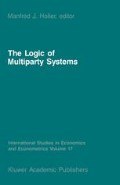Abstract
Just as most continental European legislatures, the Norwegian parliament uses the successive voting procedure. This article discusses what kind of manipulatory strategies Norwegian legislators may use. By far the major part of Storting voting seems, however, to be sincere or non-strategic. The part of the voting process in which a manipulator is most likely to succeed occurs when the voting order is being determined. After the voting order is fixed, manipulatory manoeuvres are extremely unlikely.
Access this chapter
Tax calculation will be finalised at checkout
Purchases are for personal use only
Preview
Unable to display preview. Download preview PDF.
References
Bjurulf, B. and Glans, I. (1976). “Fràn tvablocksystem till fraktionalisering. Partiguppers och ledamòters ròstning i norska Stortinget 1969–74”, Statsvetenskaplig Tidsskrift, 79, 231–53.
Bjurulf, B. and Niemi, R. (1978). “Strategic Voting in Scandinavian Parliaments”, Scandinavian Political Studies, 1, 5–22.
Black, D. (1968). The Theory of Committees and Elections. Cambridge University Press, Cambridge.
Brams, S. and Zagare, F. (1977). “Deception in Simple Voting Games”, Social Science Research, 6, 257–72.
Chamberlin, J.R., J.L. Cohen, and C.H. Coombs (1984). “Social Choice Observed: Five Presidential Elections of the American Psychological Association”, The Journal of Politics, 46, 479–502.
Farquharson, R. (1969). Theory of Voting. Basil BlackweU. Oxford
Gibbard, A. (1973). “Manipulation of Voting Schemes: A General Result”, Econometrica, 41, 587–602.
Goodin, R. (1980). Manipulatory Politics. Yale University Press, New Haven.
Grofman, B. (1981). “The Theory of Committees and Elections: The Legacy of Duncan Black”, in G. Tullock (ed.), Toward a Science of Politics, Public Choice Center, Blacksburg.
Hylland, Aa. (1976). “Stategy-Proof Voting Procedures for Single-Peaked Preferences”, Mimeo, Institute of Political Science, Oslo.
Kramer, G. (1977). “Some Procedural Aspects of Majority Rule”, in J. Roland Pennock and J.W. Chapman (eds.) Due Process, Nomos XVIII, New York.
Miller, N. (1977). “Graph-Theoretic Approaches to the Theory of Voting”, American Journal of Political Science, 21, 769–803.
Niemi, R. (1983). “Why So Much Stability? Another Opinion”, Public Choice, 41, 261–70.
Nurmi, H. (1983). “Voting Procedures: A Summary Analysis”, British Journal of Political Science, 113, 181–208.
Nurmi, H. (1984). “On Taking Preferences Seriously”, in D. Anckar and E. Berndtson (eds.), Essays on Democratic Theory. The Finnish Political Science Association, Helsinki.
Ramstedt, T. (1961). Parlamentarisk Beslutsteknik. SOU 1961: 21, Stockholm.
Rasch, B.E. (1986). “Manipulation and Strategic Voting in the Norwegian Parliament”, Public Choice, forthcoming.
Riker, W. (1982). Liberalism Against Populism. Freeman, San Francisco.
Satterthwaite, M. (1975). “Strategy-Proofness and Arrow’s Conditions”, Journal of Economic Theory, 10, 187–217.
Straffin, P.D. (1980). Topics in the Theory of Voting. Birkhäuser, Boston.
Author information
Authors and Affiliations
Editor information
Editors and Affiliations
Copyright information
© 1987 Martinus Nijhoff Publishers, Dordrecht, The Netherlands
About this chapter
Cite this chapter
Rasch, B.E. (1987). Manipulation in a Multiparty Parliament: The Case of the Norwegian Storting. In: Holler, M.J. (eds) The Logic of Multiparty Systems. International Studies in Economics and Econometrics, vol 17. Springer, Dordrecht. https://doi.org/10.1007/978-94-009-3607-2_5
Download citation
DOI: https://doi.org/10.1007/978-94-009-3607-2_5
Publisher Name: Springer, Dordrecht
Print ISBN: 978-94-010-8114-6
Online ISBN: 978-94-009-3607-2
eBook Packages: Springer Book Archive

